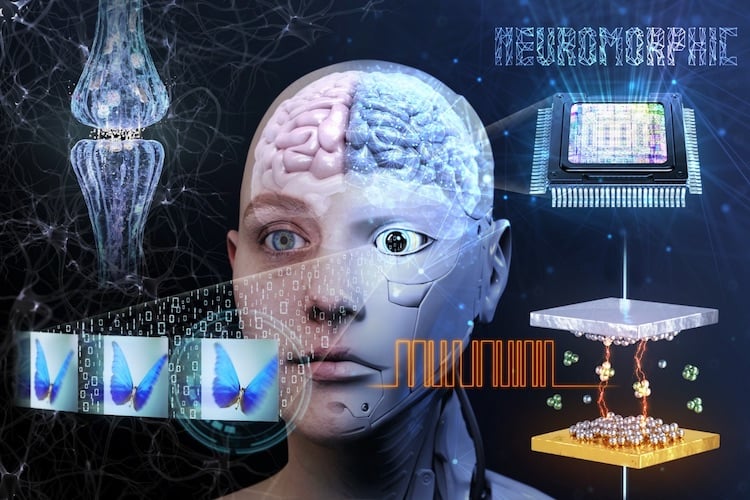A team of researchers at the Korea Institute of Science and Technology (KIST), led by Dr YeonJoo Jeong's team at the Center for Neuromorphic Engineering, has announced an artificial synaptic semiconductor device that overcomes several challenges in neuromorphic system development.
In this article, we discuss the limitations and challenges facing artificial synapse devices and neuromorphic computing, and analyze the significance of the research.
Mimicking the Human Brain
After the development of the first practical memristor (memory resistor), artificial synapses have gained a lot of research attention. Electronic devices and emerging artificial intelligence (AI)-based applications demand faster and more powerful processing units, and memristors are considered a potential hardware element for the AI era.

As shown in this concept image from the KIST researchers, artificial semiconductor-based synapses seek to mimic the human brain. Image used courtesy of KIST
As transistors shrink, quantum tunneling effects get significant, leading to high leakage currents and increased power consumption. Artificial synapses address these issues by mimicking the human brain and promise to extend the performance of electronic devices beyond the limits of the von Neumann architecture.
However, the linear behavior of the memristors leads to considerable voltage drop with varying resistance, increasing latency and energy consumption. The KIST research team solved this problem by addressing the switching parameter and reduction probability. They introduced a cluster-type analogue memristor for high-performance neuromorphic computing.
Artificial Synaptic Devices
In the conventional von Neumann architecture, the central processing unit (CPU) is separated from memory. Therefore, energy and data throughput are lost during transmission between memory storage and the processing unit. Resource-intensive tasks like image processing push the limits of conventional architecture and demand hardware with real-time data processing capabilities.
Artificial synapses, such as memristors, act as individual neurons in the human brain. Each neuron can analyze and process data at the storage location. This approach saves a lot of energy from transporting data.
The memristors can change states by just a few moving ions under a very low voltage. Once the voltage is removed, the ions hold their place, and the state retains without further energy consumption. On the other hand, devices such as static random-access memories (SRAMs) require a small charge to maintain the data.
In a neuromorphic system, hundreds of layers of resistive switching matrices are integrated over traditional digital circuits to achieve high performance.
However, memristors act linearly with varying resistance. As the filament grows with varying resistance in these devices, the electric field increases and starts positive feedback resulting in rapid filament growth and electric field increase. This issue leads to high power consumption and latency.
Researchers suggest that non-linear behavior is highly desirable for these devices to reduce latency and energy consumption, but linearity in conductance is necessary for a high on-off ratio (ratio of current through the switch when the switch is on and off). Therefore, there is a tradeoff between linearity and power consumption. The issue becomes much more severe with technology scaling and limits the matrix size or computational capability.
High-performance Artificial Synaptic Semiconductor
In their research paper, the researchers at KIST discovered that high ion reduction probability improves the performance of existing memristor devices. They developed a conductive-bridge RAM in which the switching depends on silver-cluster instead of filament formation, reducing the feedback effect in the electric field.

Illustration of the artificial synaptic device. Image used courtesy of KIST
The team fine-tuned the redox properties of active electrode ions by introducing transition-metal (TM) nanoclusters inside the silicon medium. They found that the titanium metal exhibited near-ideal linearity, increased on-off ratio, and up to 63 times longer data retention than existing artificial synaptic devices. They further report that their neuromorphic hardware is 50 times more efficient.
The research team confirmed the feasibility of their system by implementing an artificial neural network learning pattern and attempting AI image recognition. They found that the error rate was reduced by 60% compared to existing neuromorphic devices. Moreover, the handwriting image pattern (MNIT) recognition accuracy increased by more than 69%.

Application of the synaptic devices confirming reduced error rate. Image used courtesy of KIST
As their next step, the team now plans to manufacture a neuromorphic semiconductor chip based on the developed artificial synapse device to realize a high-performance AI system.
These efforts could open the door to new practical applications of neuromorphic computing, pushing the science of AI another step forward.
